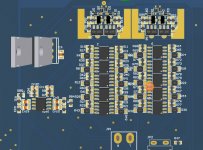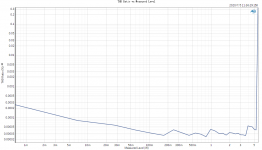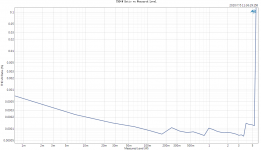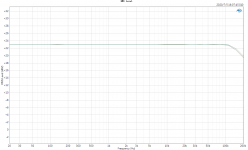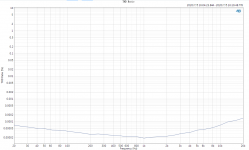Hi,
Just got interested in the OPA1656.
Any advice on how to get the spice model from TI to work with Micro-Cap?
Just got interested in the OPA1656.
Any advice on how to get the spice model from TI to work with Micro-Cap?
What is it?
Jan
opa1612+opa1656*10 composite with flying /bootstrapped supply
1A peak output current 🙂
5.5W at 32ohm and 870mW at 300ohm single ended is pretty extreme ei? As THX calls 3.9W at 32ohm extreme.
-3dBf??
Appears to be slewing johnyang1997
Doesn't appear so.
Attachments
Doesn't appear so.
LTspiceXVII fft (reset parameters) if you would....
that's 200kHz correct? Nyquist minimal @ 96kHz by 8kHz
Last edited:
LTspiceXVII fft (reset parameters) if you would....
Sorry I don't use LTSPICE.
Sorry I don't use LTSPICE.
A 100mVRMS @ 100kHz non offset (+/- 70mV) square wave response for the people?
A 100mVRMS @ 100kHz non offset (+/- 70mV) square wave response for the people?
no
-3dBf??
Appears to be slewing johnyang1997
How so? There's no indication in his graphs for any large signal non-linearity. Quite the opposite, he's basically measuring the AP residual.
Jan
There was a similar design in this forum not long ago:
"The Crocodile"
It uses a TLV172IDR at the input (bootstrapped rails) and 4xTLV2172 in the massive parallel section.
I've built it, measured it using a DIY setup, and got excellent THD results at 1kHz:
"The Crocodile"
Regards,
Braca
"The Crocodile"
It uses a TLV172IDR at the input (bootstrapped rails) and 4xTLV2172 in the massive parallel section.
I've built it, measured it using a DIY setup, and got excellent THD results at 1kHz:
"The Crocodile"
Regards,
Braca
That's pretty remarkable. However I would take care of the noise a bit more. Mine is less than 0.3uV 20KHz BW. But really really really good design especially being a finished board that actually measured that way. There are also some differences from my design. I didn't bootstrapped the first opamp because I want the first opamp to be as stable, simple, predictable as possible. I added a bit of gain in each opamp at the output stage to utilize the RRO of opa1656. 900mW(<1% THD) at 300Ohm single ended with +-24V supply is very nice imho.There was a similar design in this forum not long ago:
"The Crocodile"
It uses a TLV172IDR at the input (bootstrapped rails) and 4xTLV2172 in the massive parallel section.
I've built it, measured it using a DIY setup, and got excellent THD results at 1kHz:
"The Crocodile"
Regards,
Braca
Lastly, I am jealous on the victor oscillator. Good for you.
(I don't own that AP obviously)
Thank you.
You've got impressive results with this design - I couldn't take my eyes off your PCB.
I intend to scrutinize and redo my measurements, including the noise analysis.
I've got a less noisy notch filter now (series resistance of 11K instead of 120k in the previous one), so I'll be able to look deeper into the noise floor.
There will be also a version of this design with OPA1656 or OPA2156, and a higher supply voltage (it's 10.5V now, which is ample for my headphones), the idea being to use it as a 50 Ohm attenuator driver for the Victor's oscillator.
Regards,
Braca
You've got impressive results with this design - I couldn't take my eyes off your PCB.
I intend to scrutinize and redo my measurements, including the noise analysis.
I've got a less noisy notch filter now (series resistance of 11K instead of 120k in the previous one), so I'll be able to look deeper into the noise floor.
There will be also a version of this design with OPA1656 or OPA2156, and a higher supply voltage (it's 10.5V now, which is ample for my headphones), the idea being to use it as a 50 Ohm attenuator driver for the Victor's oscillator.
Regards,
Braca
Hi JohnC:
I found this thread last night as I was going down rabbit-holes looking for newer op-amps to replace TL072's in a professional audio device that has about 18 of them in each channel.
Would you recommend your OPA1656 for this task, or the OPA1642 (i'd be using SOIC to DIP adapters as the older TL072's are in DIP IC sockets). Another thought would be to use the older TLE2072, but I think the newer chips are clearly better.
The goal for this upgrade is to reduce distortion and increase clarity of audio passing through the unit since so many ICs are in the unit.
There are a few 5532's in the unit too-primarily as input and output stages, and am considering replacing with LM4562's, which I have used in other things such as tape machines and phono preamps.
Thank you, enjoyed reading all these pages, and am glad TI is making improved audio for us all to enjoy!
Dan
W1DAN
I found this thread last night as I was going down rabbit-holes looking for newer op-amps to replace TL072's in a professional audio device that has about 18 of them in each channel.
Would you recommend your OPA1656 for this task, or the OPA1642 (i'd be using SOIC to DIP adapters as the older TL072's are in DIP IC sockets). Another thought would be to use the older TLE2072, but I think the newer chips are clearly better.
The goal for this upgrade is to reduce distortion and increase clarity of audio passing through the unit since so many ICs are in the unit.
There are a few 5532's in the unit too-primarily as input and output stages, and am considering replacing with LM4562's, which I have used in other things such as tape machines and phono preamps.
Thank you, enjoyed reading all these pages, and am glad TI is making improved audio for us all to enjoy!
Dan
W1DAN
- Home
- Vendor's Bazaar
- OPA1656: High-Performance CMOS Audio Op Amp
